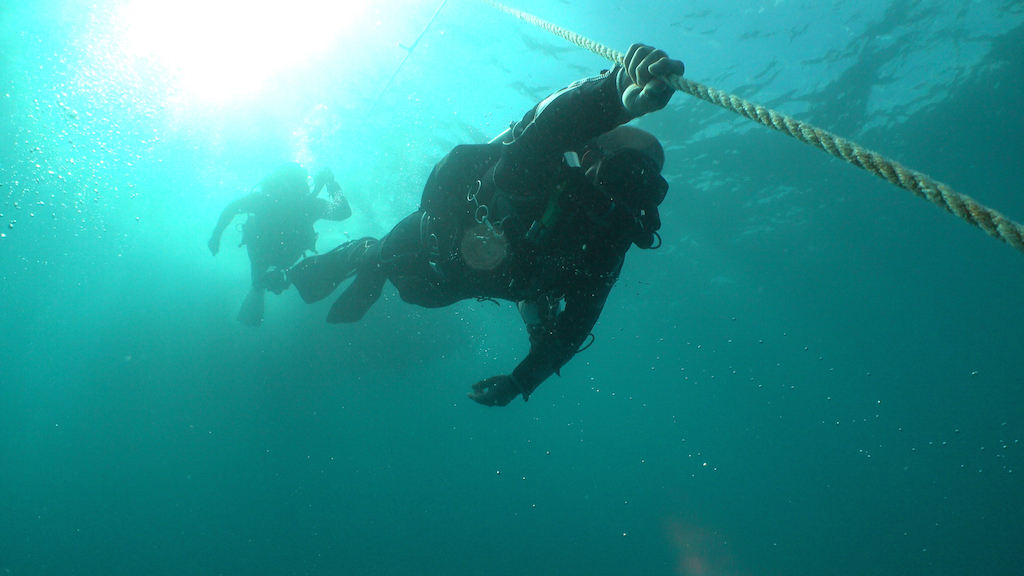A grappling hook is at the heart of the strange circumstances surrounding the shocking death of Canadian filmmaker Rob Stewart in January 2017. Stewart was the acclaimed director behind Sharkwater.
“I’m an enormous fan of Rob Stewart’s work,” documentary director Robert Osborne told rabble.ca through an email. Osborne is also a longtime diver.
“How many people on the planet can say they were instrumental in saving a species from annhilation?”
Osborne’s journalistic sensibilities were piqued after hearing about some anomalies in Stewart’s death.
His documentary The Third Dive: The Death of Rob Stewart (launching on CBC Docs POV on October 26 and available online for three years after) is a kind of what-dunnit and how-dunnit instead of a whodunnit. And it is a compelling story that also involves the medical examiner in the Florida Keys, Dr. Thomas Beaver.
Osborne is an investigative reporter with more than 30 years experience who also became a technical diver — deep diving — in the last decade. That’s why Stewart’s death drew him in. He told rabble.ca that the more digging he did surrounding the death, “the more intrigued” he became.
Stewart was working on a followup to Sharkwater, called Sharkwater Extinction (which has since been released to great reviews). When he disappeared while doing a dive for the film, the search for him became an international story.
The film starts with the frantic search, his Toronto family arriving in the Keys and the donation of search planes from the likes of singer Jimmy Buffet and billionaire Richard Branson. There is footage from police cameras that lends an air of urgency to the start and the viewer is plunged into the action and also sadly, the stomach-churning discovery of Stewart’s body.
The loss is compounded by those in the environmental community stating Stewart’s special gift as a communicator: “It’s very hard to hug an ecosystem,” says one such person. “It’s not a panda bear, it’s the lungs of the planet. He was able to make people realize it and care about it.”
‘The Keys are very political’
The documentary’s true mysteries start rolling after the 13-minute mark — after footage of the family announcing a lawsuit against the dive centre.
The community around the Florida Keys is tight. Soon, they were blaming Stewart for being inexperienced and rash. It’s also revealed that there had been diving deaths in the Keys but little reporting about them.
Osborne said that while he got pushback from the local dive community, he also had cooperation.
“Part of our success was that we didn’t try to hide what we were doing,” he wrote in an email to rabble.ca. “We were just completely upfront about it [and] I think that made people more comfortable in dealing with us.”
If you ever wanted to know about rebreathers and deep diving, Osborne’s film manages to explain it clearly while blending in his investigation.
Two main characters emerge in the film: Pete Sotis, the diver who was with Stewart at the time and who taught him how to use rebreathers, and the medical examiner.
Other sources in the film include a local reporter and another dive master, Linda Kruszka, who says: “The Keys are very political and very connected. Everybody is tied to each other.”
Sotis, to his credit, appears on camera explaining the fateful day and what he recalls happened.
Osborne presses him about the decision by Sotis and Stewart to go for a third dive that day in order to free a grappling hook that was attached to a buoy. Osborne asks Sotis why he would allow a third such dive when it’s not something most divers would do.
“I’ve never been aware it’s impossible to do three deep compression dives in one day,” responds Sotis, who is a 27-year diving veteran and adds he’s done multiple deep dives in a single day before.
He goes on to say that if his techniques were that dangerous, “there would be bodies from here to Europe.”
Sotis proves to be a good talker. There are moments where his demeanour, showing slight discomfort, can be interpreted as someone carefully choosing his words and memory but in the end, he remains steadfast.
The true protagonist
What the story does is become about concerns the efforts of Dr. Beaver, who expresses his own frustrations candidly.
Trying to find out what went wrong was “next to impossible,” said Beaver.
Beaver himself becomes a pariah in his own community. He knows the lay of the land (or, rather the water) and doesn’t even trust local authorities to examine Stewart’s dive equipment. Instead, he drives it himself from the Keys straight to the U.S. Navy Dive Unit in Panama City, in the Florida Panhandle.
Kruszka has much respect for Beaver for refusing to “just go with the flow.”
Beaver does come up with a final report, at a professional cost.
“He did what he knew was right and legal and he took the consequences for his actions,” rote Osborne in an email to rabble.ca. “I admire him for his integrity.”
The documentary has a good insight into what contributed to Stewart’s death, while at the same time exposing the closed diving community of the Keys.
Investigating Stewart’s death has caused Osborne to also reconsider his own views about the filmmaker.
“From my conversations with friends, colleagues, fellow environmentalists, I realized that Stewart took risks in order to accomplish his goals.”
The Third Dive premieres on Friday, October 26, 2018 at 9 p.m. on CBC Docs POV.
June Chua is a Berlin-based journalist who regularly writes about the arts for rabble.ca.
Photo credit: Dam Builder
Help make rabble sustainable. Please consider supporting our work with a monthly donation. Support rabble.ca today for as little as $1 per month!





